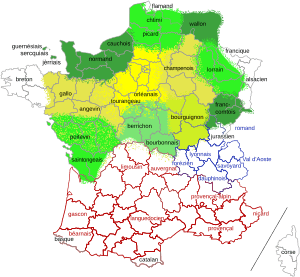Langues d'oïl facts for kids
Quick facts for kids Oïl |
|
|---|---|
| Langues d'oïl | |
| Geographic distribution: |
Northern and central France, Belgium, Switzerland |
| Linguistic classification: | Indo-European |
| Proto-language: | Old French |
| Subdivisions: |
see below
|
 The geographical spread of the Oïl languages (other than French) can be seen in shades of green and yellow on this map
|
|
Langues d'oïl (say "long doo-eel") means "languages of yes." This is a special name for a group of Gallo-Romance languages. These languages grew out of Latin in the northern parts of ancient Roman Gaul. Today, this area includes northern France, parts of Belgium, and the Channel Islands.
These languages are important because they led to modern French. They also include many other languages spoken in these regions.
Contents
What Are Oïl Languages?
The Oïl languages are part of a bigger language family. This family is called the Romance languages. Romance languages all come from Latin, the language of the ancient Romans.
Here is how the Oïl languages fit into the bigger language family:
- Romance languages (languages from Latin)
- Gallo-Romance languages (languages from Latin spoken in Gaul)
- Langues d'oïl or Oïl languages (the focus of this article)
- Langues d'oc or Occitan language (another group of languages, mostly spoken in southern France)
- Gallo-Romance languages (languages from Latin spoken in Gaul)
Where Are Oïl Languages Spoken?
The Oïl languages are mainly found in northern and central France. You can also hear them in parts of Belgium and the Channel Islands. The most famous Oïl language is French. It started as a dialect of Oïl spoken around Paris.
Over time, this Parisian dialect became the official language of France. This is why French is so widely spoken today. However, many other Oïl languages still exist. They are often spoken by smaller groups of people.
Different Oïl Languages
While French is the most well-known, there are many other Oïl languages. Some examples include:
- Walloon: Spoken in parts of Belgium.
- Norman: Spoken in Normandy, France, and the Channel Islands.
- Picard: Spoken in northern France and southern Belgium.
- Gallo: Spoken in Brittany, France.
These languages have their own unique sounds, words, and grammar. They are an important part of the cultural history of their regions. Many people work to keep these languages alive.
History of Oïl Languages
The Oïl languages began to form after the Roman Empire. When the Romans left Gaul, their Latin language changed over time. It mixed with the languages already spoken by the local people. This mix created new dialects.
These dialects slowly became different from each other. The ones in the north became the Oïl languages. The ones in the south became the Occitan languages. The name "Oïl" comes from the word for "yes" in these northern dialects. In the south, the word for "yes" was "oc," which gave the name "Langues d'oc."
Over many centuries, these languages developed. They had their own literature and traditions. Even though French became dominant, the other Oïl languages continued to be spoken.
Images for kids
-
Bilingual street sign for market square in French and Walloon
See also
 In Spanish: Lenguas de oïl para niños
In Spanish: Lenguas de oïl para niños



